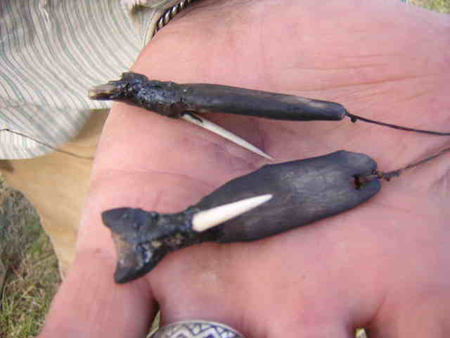By Steven Edholm We like to see things as black and white, good or bad, better and worse. It helps us function in daily life where we need to make fast judgements or live on cruise control without having to over analyze everything. But it is also a trap that can limit us and cause us to do really dumb stuff. It helps to look at things in context. We can pit antler against bone to see which one is better for tools and such, but the victor will be dependent on circumstance and what it is that we are trying to accomplish, rather than on more arbitrary grounds. Both Tamara and I have largely gravitated toward espousing and detailing the qualities of materials as a way to view paleotechnics. While our feeble minds may gravitate toward one or the other as superior, redwood is not oak, soapstone is not jade, antler is not bone, and none is superior to the other except in the context of specific uses. Bury an oak fencepost and it will probably fall over in 5 to 10 years, where redwood may last for 50 or much more. Make a bow out of redwood heartwood, but in spite of your best design efforts, it’s just going to be kind of lame.
Bone and antler are similar materials. The qualities of both can vary quite a bit, but they are still very different. bone can be more or less flexible depending on many factors, like what part of the animal, what species, age etc.. but antler is, by it’s nature, generally tougher and more flexible than bone. Some uses of these two materials will overlap, while for others, one is clearly superior to the other. Keep these thoughts in mind as I’m speaking in generalities here.
Bone is harder than antler as a rule but, like many hard things, it is also more brittle and less likely to survive impacts, bending and twisting. However, being harder, bone also takes a better edge. It’s not going to sharpen up and hold an edge really well, but better than antler. Bone is more liable to check and crack in drying.
Antler is softer and tougher as a rule. It can be more easily bent (though major thinning is still usually required). It will not hold an edge as well, but then it also won’t snap as easily. When used to pressure flake arrow points, the stone dents into antler easily providing a ready grip. Sometimes that’s good, and sometimes the harder material of bone is better used.
Think about it. An antler is made to clash with other antlers in violent conflicts. Bucks slamming into each other with tremendous force, and then twisting and throwing their full body weights around by the antlers on their heads. I was awakened a month ago in the middle of the night by two bucks going at it down in the woods. Believe me, they are not messing around! It’s no wonder antlers sometimes break off during these fights, but they usually don’t. Antler can almost be viewed as a very hard and tough wood, though it probably exceeds all woods in these qualities. Bone has to be tough as well, but not as tough. Green bone is much more flexible than dry bone. Bones didn’t evolve to be tough after we have died, just while we are still using them. Antlers didn’t evolve to be tough after the bucks are done with them either, but they are tougher than bone to start with and still tougher than bone when cast off.
The material from which the two are made are different. Antler contains a great deal of collagen and is more related to skin than it is to bone. Over cooking it will result in a loss of collagen. That’s great if you’re making glue, but not if you want a strong piece of antler. bone will also weaken and dissolve glue making substance into the water when cooked, but it will lose that substance more slowly. My general tendency is to think that cooking either one as little as possible is ideal, though weathered bone, which has lost much of it’s glue substance, is sometimes very flexible, so I try to keep an open mind on that one.
Antler is good for pressure flaking tools, bent items, stone working batons and handles. It is easier to carve and work with, especially when soaked in water overnight. If thinned evenly and enough, it can be dropped in boiling water to heat it through and then bent into a pretty tight radius without cracking. It usually has a spongy pith that softens on soaking and heating. Other items, like blades, can be set into the soft pith, which then hardens on drying gripping the item tightly. Antler, being soft and somewhat fibrous, can't take as good a polish as bone, and the polish is as lasting.
Bone is better for edges (though not comparable to a good edge stone like flint) and tools that need to stay sharp, like an awl, it can work well as a pressure flaker depending on the circumstance. Think arrowheads, harpoon points, hide scrapers and stuff like that. Bone sometimes has as spongy looking core which can be useful as a paintbrush for painting on skin, but it's pith doesn't have the same qualities that allow antler to hold onto things like knife blades firmly. Bone can take a very high polish.
I hope this short article leads to a better understanding of the qualities and potential uses of these two useful and beautiful materials, and that I didn't forget anything important. When we understand the qualities of the materials in our world, it leads to a wide open potential for creative, adaptive responses to our needs and desires in interacting with our environments, and that is what paleotechnics is all about.






